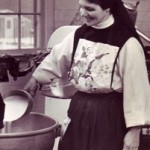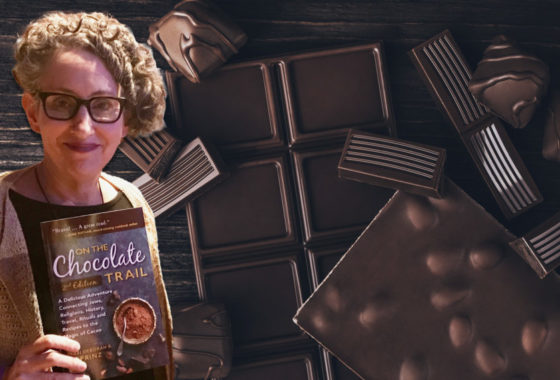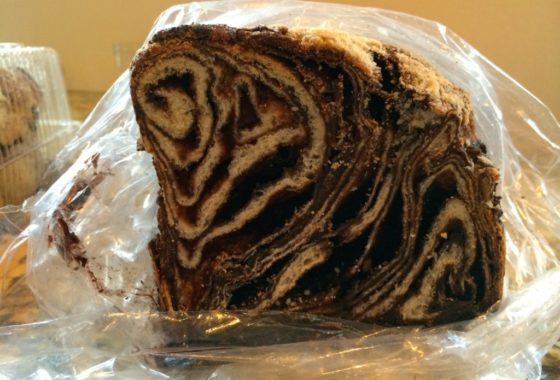Mothering with Chocolate
In 2012 consumers in the United States spent an average of $152 dollars for Mother’s Day gifts. A good portion of that was spent on slathering our mammas with chocolate treats. Earlier generations of women, some of the them childless due to their religious callings, have concocted and savored chocolate; they have contributed to the bountiful chocolate appetite evident in the current celebrations of our moms.
Aztec women received godly instructions to produce the first chocolate by beating cocoa bean paste with water in gourds. According to those earliest of chocolate sources in Aztec traditions, the beloved god, Quetzalcoatl, was said to have planted a cacao tree, collected its pods, roasted the cocoa beans, and then showed only the women how to process the beans into a spicy chocolate drink. Women guarded and transmitted those techniques.
Later, New World nuns explored creative chocolate delights. It may have been the prioress at the Dominican Convent of Santa Rosa in Pueblo de Los Angeles in Puebla, Mexico, who devised and served the first peppery mole in 1680. Oaxaca nuns were famous for their cinnamon-and anise-flavored chocolate drinks. The Concepcionista sisters of Regina Coeli of Mexico City so adored their chocolate that they were called monjas chocolateras, chocolate nuns.
Chocoholic women in 17th century Chiapas, Mexico, toted their chocolate making paraphernalia with them to Mass. When the local bishop condemned these chocolatey disruptions of the holy ceremonies and threatened to excommunicate violators, the women protested that they could not be in church without their chocolate and ignored the edicts. One day the priests rudely grabbed their chocolate cups out of their dainty hands. The husbands gallantly pulled their swords to protect their chocolate-besotted wives. The nuns and friars in neighborhood churches were more indulgent about chocolate.
When that bishop mysteriously fell very ill, his physicians concluded that he had been poisoned. One of his opponents argued against grieving for the bishop. She claimed that because the cleric strictly opposed cocoa in church, the chocolate that he had swallowed in his own home had disagreed with him. Thus, the proverb: “Beware of the chocolatte of Chiapa!”
The fluidity between church, women and chocolate melted into the 18th century as well. Since 1763 women have owned and run Caffè al Bicerin in Turin, Italy. Its location near the Santuario della Consolata brought women to the intimate, low-ceilinged, candlelit space to break their Lenten and Communion fasts with bicerin, a perfect beverage layered with hot chocolate, coffee and cream. Expertise about chocolate also infused Madame d’Arestrel, the Mother Superior of the Convent of the Visitation at Belley, France. She sensed God’s part in this chocolate preparation when she advised: “When you want to have good chocolate, have it made the night before in a porcelain pot and leave it. The repose of the night concentrates it and gives it a velvet quality which improves it greatly. The good God cannot possibly take offence at this little refinement, since he himself is everything that is most perfect.”
Today, the fifty nuns of Mount Saint Mary’s Abbey in Massachusetts depend on their chocolate business, Trappistine Quality Candy, to fulfill their spiritual mandate to live by the work of their hands and to support themselves. This reasonably priced chocolate, available on line, furthers the chocolate works of earlier generations of women.
This mother’s day we raise our chocolate treats, in all their glorious shapes and cacao content, in celebration of our mothers, real and symbolic.
Cross Posted at The Huffington Post
Recent Posts
-
Sweet Treat: Chocolate and the Making of American Jews
You may wonder: how did chocolate help define American Jews? Through chocolate, we see that Jews were part of America since its earliest days. Well, since 1701 at least, Jews in the Colonies made part of their living through chocolate. Several Sephardim, leaders of their New York and Newport Jewish and secular communities, participated in
Read more › -
How About Some Uterus Challah?
When Logan Zinman Gerber felt enraged about the loss of reproductive rights in the U.S., she baked challah. Not any challah. She shaped it into a uterus. It wasn’t long after the birth of her daughter that Gerber, a longtime challah baker and staff member of the Religious Action Center of the Reform movement, considered
Read more › -
A Manhattan synagogue explores the rich, surprising history of Jews and chocolate
I’m grateful for this story written by Rachel Ringer, published at JTA/NY Jewish Week on December 20, 2023: (New York Jewish Week) — In 2006, Rabbi Deborah Prinz was on a trip to Europe with her husband, Rabbi Mark Hurvitz, when they wandered into a chocolate shop in Paris. While meandering about the store, Prinz picked
Read more › -
Exhibit Opens! Sweet Treat! Chocolate & the Making of American Jews
Sweet Treat is a delicious gastronomic adventure into the history and resilience of American Jewish chocolate making. This exhibition invites you to follow the chocolate trail to America, a scrumptious journey through time and place. Chocolate gives us a lens to understand Jewish migration, as the chocolate trade parallels the migrations of the Jewish
Read more ›
Some Previous Posts
(in alphabetical order)
- "Boston Chocolate Party" Q&As with Deborah Kalb
- 2022 Media for The "Boston Chocolate Party"
- About Rabbi Deborah Prinz
- Baking Prayers into High Holiday Breads
- Boston Chocolate Party
- Chocolate Chip Politics
- Digging into Biblical Breads
- For the Easiest Hanukah Doughnuts Ever
- Forthcoming! On the Bread Trail
- Funny Faced Purim Pastries
- Good Riddance Chameitz or, The Polemics of Passover's Leaven
- Injera*
- Israeli Chocolate Spread
- Jewish Heritage Month: Baseball & Chocolate!
- Matzah - But, the Dough Did Rise!
- Plan a Choco-Hanukkah Party: 250th Anniversary Tea Party
- Prayers Into Breads
- To Shape Dough: A Trio of Techniques
- Why Is Challah On My Matzah Box?





